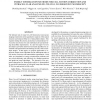Free Online Productivity Tools
i2Speak
i2Symbol
i2OCR
iTex2Img
iWeb2Print
iWeb2Shot
i2Type
iPdf2Split
iPdf2Merge
i2Bopomofo
i2Arabic
i2Style
i2Image
i2PDF
iLatex2Rtf
Sci2ools
ISBI
2009
IEEE
2009
IEEE
Energy Minimization Methods for Cell Motion Correction and Intracellular Analysis in Live-Cell Fluorescence Microscopy
The ultimate aim of many live-cell fluorescence microscopy imaging experiments is the quantitative analysis of the spatial structure and temporal behavior of intracellular objects. This requires finding the precise geometrical correspondence between the time frames for each individual cell and performing intracellular segmentation. In a previous paper we have developed a powerful multi-level-set based algorithm for automated cell segmentation and tracking of many cells in timelapse images. In this paper, we propose approaches to exploit the output of this algorithm for the subsequent tasks of cell motion correction and intracellular segmentation. Both tasks are formulated as energy minimization problems and are solved efficiently and effectively by distance-transform and graph-cut based algorithms. The potential of the proposed approaches for intracellular analysis is demonstrated by successful experiments on biological image data showing PCNA-foci and nucleoli in HeLa cells.
| Added | 19 May 2010 |
| Updated | 19 May 2010 |
| Type | Conference |
| Year | 2009 |
| Where | ISBI |
| Authors | Oleh Dzyubachyk, Wiggert A. van Cappellen, Jeroen Essers, Wiro J. Niessen, Erik H. W. Meijering |
Comments (0)

